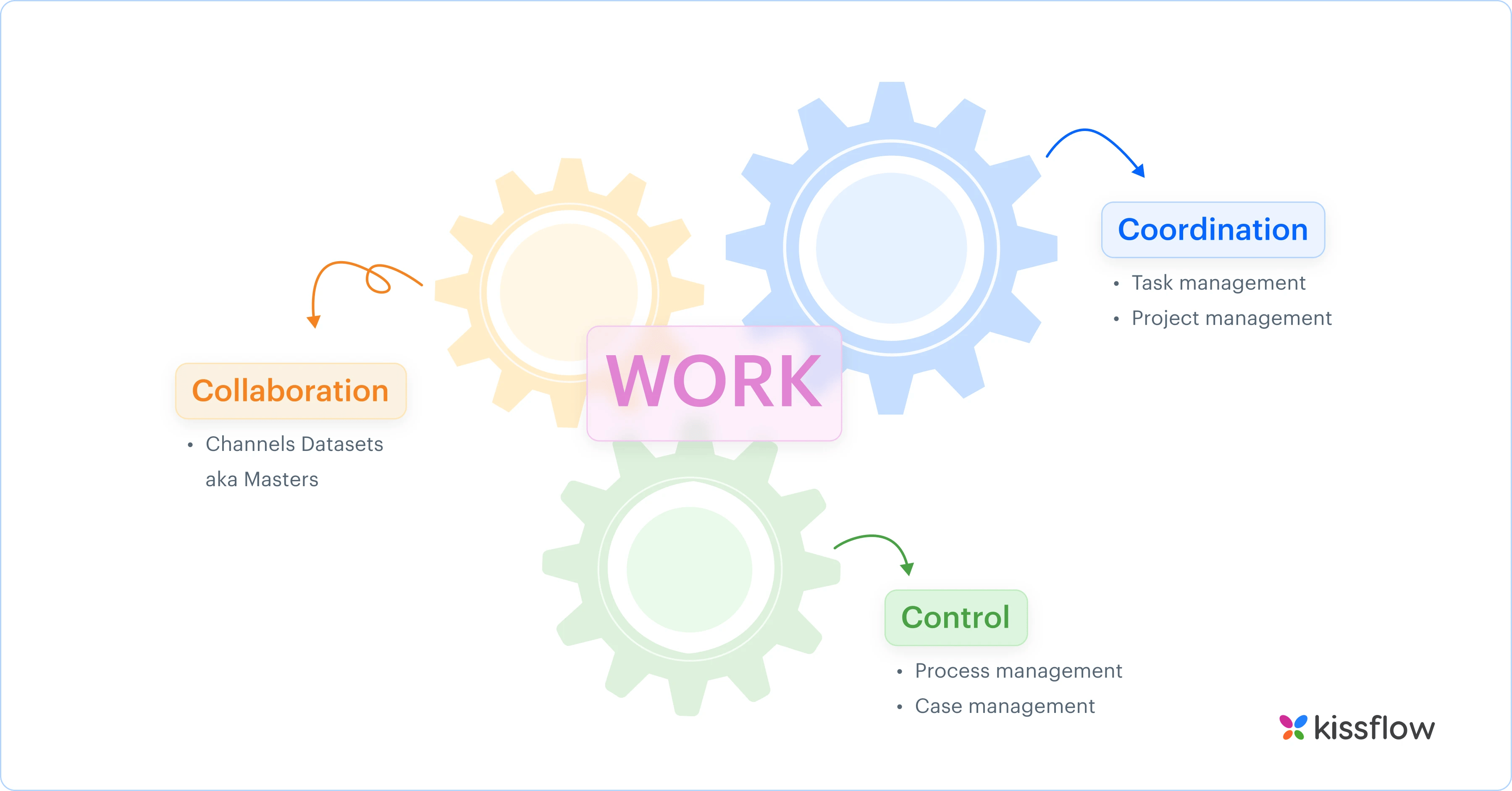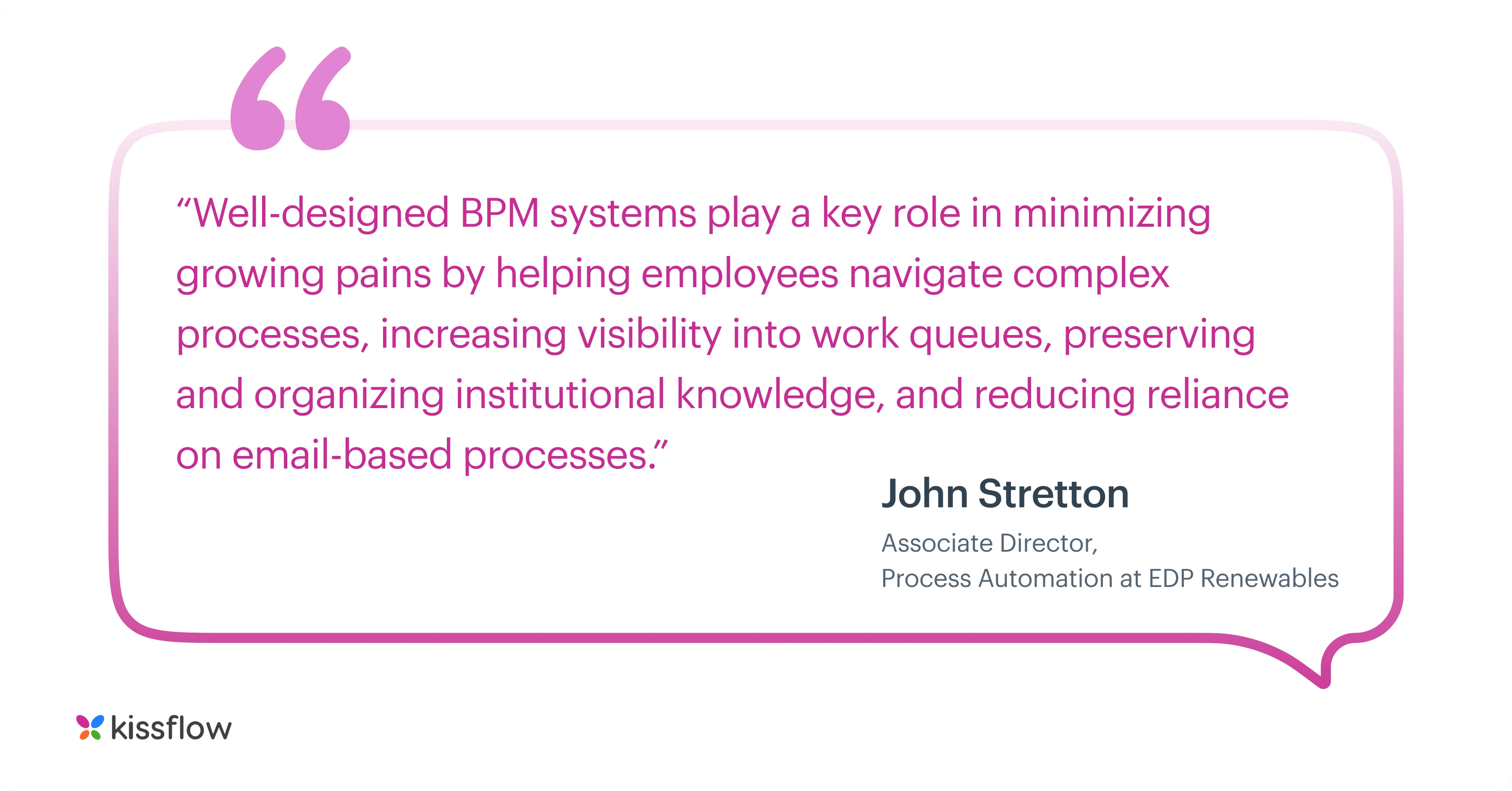
- >
- BPM Software >
- The Complete Guide for Business Process Management (BPM)
The Complete Guide for Business Process Management (BPM)
Team Kissflow
Updated on 15 Jul 2024 • 6 min read
In the ever-evolving business world, CIOs and business technology partners are the masterminds of tech innovation. They know that managing processes efficiently can be a tough nut to crack for any business, big or small. But contrary to popular belief, BPM isn't a luxury—it's a game-changer.
For CIOs and BTPs, BPM isn't just another tool. The rocket fuel propels organizations forward, no matter their size.
This guide is your ticket on a journey into the heart of BPM. We'll bust myths and highlight how BPM can transform businesses of all sizes. From streamlining operations to cutting costs through automation, we'll arm tech leaders with the knowledge to leverage BPM as a strategic powerhouse, prepping every process for success in the digital era. Let's dive in!
What is BPM?
Business process management (BPM) involves the method of designing, scrutinizing, and enhancing comprehensive business procedures to align with your strategic business objectives, such as enriching your customer experience structure.
Business process management is also defined as an organizational discipline where a company takes a step back and looks at all these processes individually. It analyzes the current state and identifies areas of improvement to create a more efficient and effective organization.
Each department in a company is responsible for taking some raw material or data and transforming it into something else. There may be a dozen or more core processes that each department handles.

What is a Business Process Management strategy?
Business Process Management (BPM) strategy involves defining, designing, executing, monitoring, and optimizing business processes to increase efficiency, effectiveness, and agility.
Why is BPM important?
Business process management helps organizations improve efficiency, productivity, and agility. It involves defining, designing, executing, and continuously improving organizations' processes to produce goods and services. By streamlining processes and eliminating bottlenecks, organizations can reduce costs and improve the quality of their products and services.
In addition, business process management helps organizations to be more responsive to changing customer and market needs and to adapt quickly to new technologies and business models. Organizations can become more competitive and achieve long-term success by effectively managing their processes.
Say no to chaotic work. Automate your tasks now.
What is the purpose of Business Process Management?

When left unorganized and unsystematized, poor business processes can lead to mayhem. At the individual level, people only see one part of a process. Very few can scan out and see the full effects of a business process, where it starts and ends, the key data needed, and where potential bottlenecks and inefficiencies lie.
Unmanaged, chaotic processes hurt business and lead to one or more of these scenarios:
-
Time wasted
-
More errors
-
Increased blame
-
Lack of data
-
Demoralized employees
Organizations can improve their processes by applying business process management and keeping all operations running optimally.

Steps of the BPM Lifecycle
 Step 1: Design
Step 1: Design
Most processes include a form to collect data and a workflow to process it. Build your form and identify who will own each task in the workflow. This is also called business process mapping.
Step 2: Model
Represent the process in a visual layout. Fix details like deadlines and conditions to give a clear idea of the sequence of events and the flow of data through the process.
Step 3: Execute
Execute the process by testing it live with a small group first and then opening it up to all users. Make sure you restrict access to sensitive information.
Step 4: Monitor
Keep an eye on the process as it runs through the workflow. Use the right metrics to identify progress, measure efficiency, and locate process bottlenecks to ensure process monitoring is done effectively.
Step 5: Optimize
As you analyze, notice any changes that need to be done to your form or workflow to make them more efficient. Consider business process improvement steps.
Read more: An Amateur’s Guide to the BPM Life Cycle
Say no to chaotic work. Automate your tasks now.
Best Practices in Business Process Management
Several best practices have emerged over time to assist in BPM, which is a complex process improvement strategy. Organizations can follow them to manage their business processes effectively:
1. Define clear goals and objectives
It is important to understand the desired outcomes of a business process and to ensure that the process is aligned with the organization's overall goals.
2. Involve stakeholders
Involving key stakeholders in the design and management of business processes can help ensure buy-in and support for process improvements.
3. Document and analyze processes
Detailed documentation of business processes can help organizations understand how they work, identify areas for improvement, and track progress over time.
4. Use process modeling techniques
Process modeling techniques like flowcharts and BPMN can help organizations visualize and understand their processes and identify potential bottlenecks and inefficiencies.
5. Continuously monitor and measure process performance
Organizations should regularly monitor and measure the performance of their business processes and use this data to identify and address any issues or problems.
6. Use technology to automate and optimize processes
Automation and technology can help organizations streamline and optimize their processes, reducing the need for manual labor and improving efficiency.
7. Foster a culture of continuous improvement
Encouraging a culture of continuous improvement can help organizations stay agile and adaptable and ensure that their processes are continuously evolving to meet changing needs.
What are the benefits of incorporating Business Process Management?

Here are some of the primary benefits of using BPM in your business:
- Gain control of chaotic and unwieldy processes
- Create, map, analyze, and improve business processes
- Run everyday operations more efficiently
- Realize bigger organizational goals
- Move toward digital transformation
- Improve and optimize tangled operations
- Closely track individual items as they move through a workflow
What are the types of Business Process Management?

BPM systems can be categorized based on the purpose they serve. Here are the three types of business process management:
1. Integration-centric BPM
This type of business process management system handles processes that primarily jump between your existing systems (e.g. HRMS, CRM, ERP) without much human involvement. Integration-centric business process management systems have extensive connectors and API access to be able to create processes that move fast.
2. Human-centric BPM
Human-centric BPM is for those processes that are primarily executed by humans. These often have a lot of approvals and tasks performed by individuals. These platforms excel at a friendly user interface, easy notifications, and quick tracking.
3. Document-centric BPM
These business process management solutions are required when a document (e.g., a contract or agreement) is at the heart of the process. They enable routing, formatting, verifying, and getting the document signed as the tasks pass along the workflow.
Most business process management systems will be able to incorporate elements of each of these, but each one will usually have one specialty.
Business Process Management examples
1. HR
Have you ever felt your organization’s onboarding process is too complex and chaotic? Is your HR department asking the candidates to fill out paper forms that make them exhausted? This is because your HR department lacks the principle of Business Process Management (BPM). Applying business process management, helps you automate your HR processes end-to-end, thereby cutting down on cost, time, and paper forms. Here are a couple of examples as to how business process management helps your HR department to improve their processes:
- Approve employee timesheets faster
- Onboard new hires without hassles
-> Here are 6 business process management examples from companies that implemented BPM.
2. Sales
In most organizations, the sales team spends a significant amount of time coordinating with the Accounts Receivable (AR) team to get sales invoices approved. Even a small typo in invoices ruins the lives of the salespeople. This is where business process management comes into the picture since it automates the invoice approval process, thereby eliminating the chances of manual errors and the back-and-forth clarifications between the salespeople and the AR team. Here are a couple of scenarios in the sales department where business process management can help them streamline their processes:
3. Finance
A finance team is bombarded with paper forms and emails every day since anything that involves money has to go through them. For instance, if the asset management team wants to purchase 50 laptops, they send the quotation that they received from the vendor to the finance team for approval. This is just one case. Imagine how many emails and paper forms they receive on a daily basis from various teams. Without a system in place, it is cumbersome for them to manage all of these. Business process management (BPM) software helps them manage all of this. Here are a couple of scenarios in the finance department where business process management comes as a saving grace:
- One-click approvals for travel requests
- Customize workflows for unique scenarios
Features every Business Process Management tool should have
Now that you know why exactly a BPM system is necessary, here’s a list of the features a good business process management system should have.
- Visual process diagramming tool
- Drag-and-drop form designer
- Role-based access control
- Mobile support
- Lead management solution
- Powerful administrator features
- Single sign-on (SSO)
- Integration with existing software systems
- Reports and analytics
- Performance for large user bases
- Process performance metrics
Read this article for a detailed explanation of the above features of a good business process management system.
Is BPM like task or project Management?
Business process management is neither task management (which focuses on individual tasks) nor project management (which handles one-time or unpredictable flows).
Task management is handling or organizing a set of activities arising from a project. These projects are often one-time and non-repeatable. Project management software like ' Microsoft Project ' is used when these projects are well-organized, like in construction work. Trello, Asana, or Kissflow are good tools for managing tasks in ad-hoc projects.
Business process management is focused more on repetitive and ongoing processes that follow a predictable pattern or process management.
Try Kissflow to manage your business processes
Ready to take your Business Process Management (BPM) up a notch? Give Kissflow a spin! It's a user-friendly, low-code platform that makes managing business processes a breeze. Whether in IT, finance, or HR, Kissflow has got you covered.
Create your apps, streamline workflows, and boost efficiency. Plus, with its mobile compatibility, you can manage your work anytime, anywhere. Try Kissflow today and propel your business toward success!

7e16.jpg)






